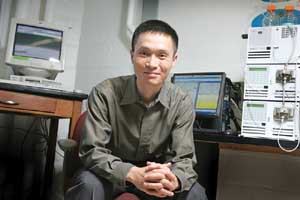He to use Keck grant to continue research on DNA repair
By Steve KoppesNews Office
 Chuan He | |
Biology and chemistry come together in Chuan He’s laboratory like the tightly wound strands of a DNA molecule.
He uses the tools of biochemistry and molecular biology as well as chemistry to study DNA repair, the process through which cells protect their genetic material from damage that can lead to cancer and other diseases.
The W.M. Keck Foundation has named He one of five Distinguished Young Scholars in Medical Research for 2004, supporting his work with a $1 million grant.
“Our genome is constantly subjected to damage,” said He, Assistant Professor in Chemistry and the College. “DNA is damaged by water, by sunlight, by the oxygen we breathe and by the chemicals with which we come into contact.”
Fortunately, cells have complicated systems to repair the damage and prevent disease. Decades of research have revealed much about the repair process. In many cases, scientists have even associated certain proteins with the repair of specific types of damage. But how these proteins find the damaged DNA in the first place remains a problematic mystery.
It is a molecular-needle-in-a-haystack proposition. The human genome contains roughly three billion base pairs, which code genetic information. The base pairs needing repair may number only in the hundreds at a given time, yet repair proteins efficiently sniff them out.
He has developed a new experimental method for studying the interactions between DNA and the repair proteins.
Research in this field in recent years has focused on how proteins bind to damaged DNA. Repair proteins typically bind tightly to damaged DNA in a specific place on the molecule, making it relatively easy for researchers to study the proteins’ structure and function.
Nevertheless, scientists still lack an understanding of how these proteins interact with undamaged DNA. This information would be critical for revealing mechanisms these proteins use to search for and locate DNA lesions. He’s group has developed a method involving modifying the DNA molecule so it traps the protein, making it possible to characterize distinct states of the protein/DNA interaction.
In another aspect of his research, He synthesizes molecules that mimic damaged DNA, and then uses them as bait to fish out repair proteins and identify previously unknown ones. “By doing so, I hope to develop a comprehensive picture of DNA damage recognition and repair inside cells,” he said.
Thus far, He knows his novel experimental technique works well on individual proteins. But can it be applied on a large scale, to thousands or tens of thousands of proteins derived from a human cell? That is what He hopes to demonstrate to the scientific community in the coming year. “I am very optimistic about the potential of this method. I think it will give us some really exciting results in the next three to five years,” he said.
He survived a rigorous national competition to receive his Keck grant. The Keck Foundation invites 30 research universities annually to nominate one junior faculty member for consideration. As one of 10 semifinalists, He flew to Los Angeles for a face-to-face interview with Keck’s selection committee.
He attributes his successful interview to the preparation he received from Fred Stafford, Director of Special Projects in the Office of the Vice President for Research and for Argonne National Laboratory; Kathy Purnell, Assistant Director of Foundation Relations; and several colleagues in the Physical and Biological Sciences divisions.
“The research ideas in my lab grew in the last two years by talking to students and particularly colleagues in the Chemistry Department, at the hospital and from the Biological Sciences Division,” He said.
“The University of Chicago is the best place for assistant professors. I really mean that. In the Chemistry Department, all of the assistant professors are doing extremely well. I think it’s because of the support we get from the department, the Physical Sciences Division and the University,” he added.
![[Chronicle]](/images/sidebar_header_oct06.gif)